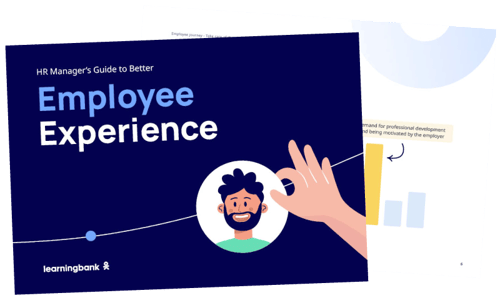Employee Experience in 2023: The HR Manager’s Guide to Employee Journey
In order to create a better Employee Experience in 2023, HR leaders and managers need to take care of the employee journey from onboarding to offboarding and focus on an employee in the long term. But where do you start? What does it take? How do you tackle the challenges? Read our guide here.
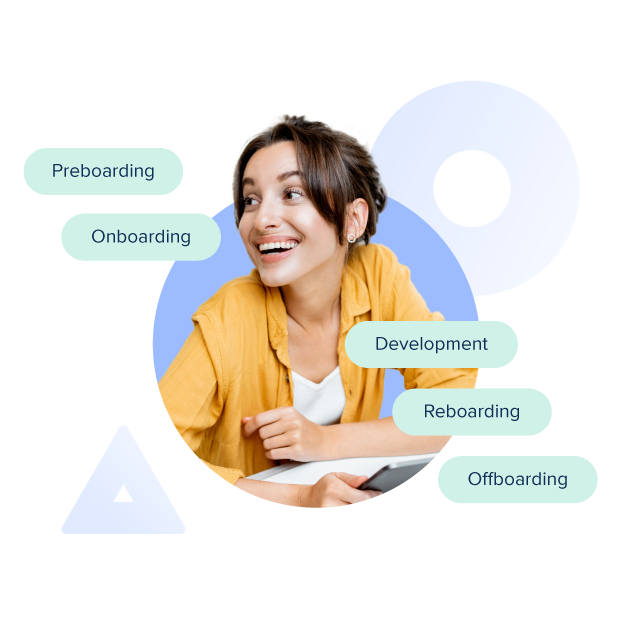
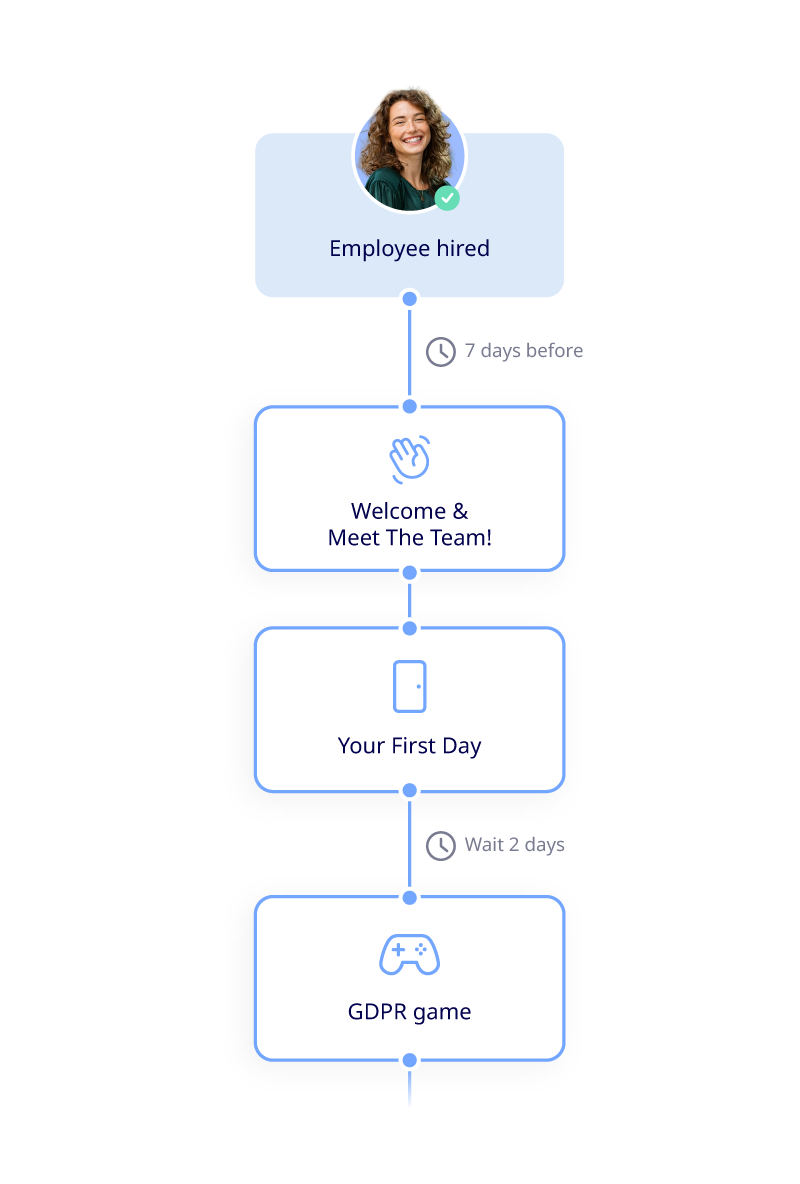
Take Care of the Employee Journey from Onboarding to Offboarding
The numbers of employees quitting or considering quitting their jobs are spiking. A recent study shows that 40% of workers are considering quitting their current jobs in the next 3-to-6 months.
Organizations that learn why this is happening and take action accordingly will have an advantage in attracting and retaining talent. If it’s something we have learned in the past years, it is that it’s not enough only to identify the right talent pool or increase salaries to make employees join a company or stay in a job.
Organizations need to ensure that employees are well received and have good opportunities to develop throughout their employment and eventually give a nice good-bye when that day comes. It's about making the whole employee journey a good employee experience. And that is what we will focus on on this page.
We will take you through the employee journey and delve into the different phases you should be aware of. You’ll get specific tips and tricks on how to take on new employees and get them onboard in the best way, and we give advice on how to ensure that they develop and get the professional vitamins that keep them happy on the job.

Living Up to Expectations of Today's Employees & Technological Potential
At some level, it is pointless to talk about the labor market as a fixed size, where the reality is the same, whether we are looking at Denmark, the United States, Senegal, or Vietnam. However, once that reservation has been made, there are some macro-trends that managers and HR managers globally should relate to.
It is a fact that there is a struggle in securing the most talented employees. There is talk of “War for talent”, and although the war rhetoric may seem a bit extreme, it is in fact quite pertinent. At the end of the day, it is about securing the right resources in the form of employees who can keep the business running as well as developing it. The alternative is stagnation and then termination – or in other words: Life or death.
And “securing” must be understood in broad terms – it is more than simply identifying, attracting, and onboarding attractive employees. Once onboard the organization, the work on training and developing the employees begins.
Since 2020, we also see that work-life balance has become an even more important factor for people. Workers no longer stay in companies where they don’t feel appreciated or listened to. And there is an increasing demand for development in the workspace as well as flexibility and the ability to work (at least partly) remote.
Workers today also have an enormous demand for professional development and being motivated by the employer. If the employer does not want to help the individual employee develop professionally and personally, it is likely that the employee will look for a new place to fulfil themselves. Companies and organizations must therefore recognize that the task of hiring and developing employees must be seen as a process - a journey - which is based on the employees, their expectations, wishes and dreams. Together it becomes the overall employee experience.
Additionally, the younger generations that’s taking up more and more of the workforce, have grown up as digital natives. This needs to be embraced by employers and in relation to the employee journey, this will materialize in greater focus on use of gamification, digital learning and microlearning. Technologies and learning methods are based on the recipient to a much higher degree than the sender. If you fail in this challenge, you might end up losing the fight for talent.What is Employee Experience anyway?
Josh Bersin defines employee experience as a "company-wide initiative to help employees stay productive, healthy, engaged, and on track." It can for example help battle work-related stress, which is on the rise.
Employee experience is no longer an HR project. It's about the total company and all activities you can do to make sure the employee is satisfied with other important areas than just salary and company benefits. This is what technology can help us with.
Today, you find many different platforms helping you carry out a better employee experience - for good reasons. The future of work calls for it - and if you are not on track, you risk losing your top talent to your competitors.
Employee experience management is crucial to human resources. If your employee experience framework is on point, you drive positive experience and performance management that can engage employees. As a result, you see the effect on your key drivers to success and maybe even in real-time in the office.
Employee experience and employee engagement (where you for example find results via engagement surveys) are common in HR - but it has become more challenging.
Hard Technology and Soft Skills
In the wake of the technological evolution that is developing exponentially in the so-called fourth industrial revolution, the doomsday prophets have spoken of a significant change in the labor market in which people are replaced by robots. However, in PwC’s CEO survey, as many as 54 percent of respondents indicated that they expect to hire more people.
“Organizations need to strengthen their innovation, digital, and technology capabilities in order to capitalise on new opportunities, and they need the skills to support that investment.”
Source: “21st CEO Survey”, PwC
The same survey shows that 80 percent of top executives are worried about whether they can find the right people for critical job functions, while 91 percent identify a need to cultivate the so-called soft skills.
Soft skills specifically are worth dwelling on. The concept may be difficult to define exactly, but it covers the competencies that are difficult (if not impossible) to replace with artificial intelligence (AI), algorithms and server parks. In other words, there is a need for people who contribute with creativity, social skills, and the ability to deviate from the schedule if something unexpected happens.
It is too early to discharge the HR department and hope that computers will manage the rest. Instead, you should take the employee journey seriously and make sure that you as a company have mastered the entire journey from A to Z.
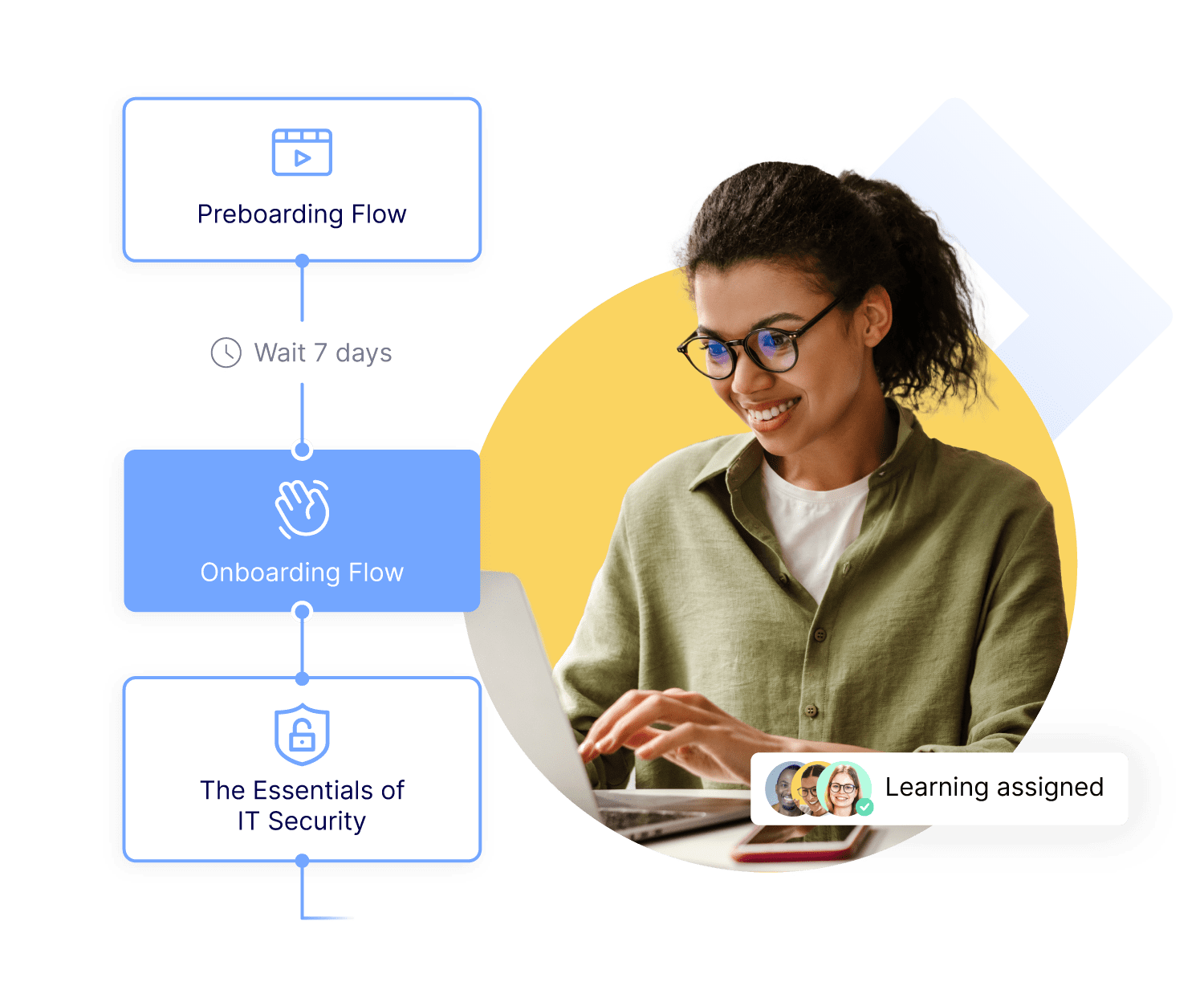
Preboarding: Cast a Secure Foundation
Everything is new when an employee steps through the door of their new workplace. It may be difficult enough to relate to new colleagues, new surroundings, new tasks and everything else that is also new. But in fact, the butterflies in the stomach often begin to flutter sometime before – namely during the time from the signing of the employment contract to the first day at work.
Anyone who has changed jobs or has tried to enter the labor market for the first time has sat in front of a screen to find out as much as possible about their new workplace. What kind of a place is this? Who and how are the new colleagues? What about the company’s history and customers or business partners? And what about all of the countless other things that could be nice to know before standing there at the door as the employee who knows nothing yet?
Bad Recruitments Can Be Expensive
Ultimately, it’s all about security. Security for the new employee, but also for the company. It is crucial that companies succeed in welcoming new employees in a way that increases the likelihood of them staying at the job.
When you look at the figures, a bad recruitment winds up costing up to USD 75.000. And as 25% of all new recruits stop before a year is up, it is obvious that investing in this area is sound business.
Fortunately, the figures also show that you reduce the risk of the employee disappearing again within the first year by 87% if you ensure that the employee is committed.
The First Step
The employee journey starts with preboarding (or at least should start with it). Preboarding occurs during the period from the signing of the contract until the first day of work for the employee and it minimizes the time-to-performance period – the time it takes for a new employee to reach a level where they can cope with their work assignments and reach their KPIs.
On a practical level, a preboarding process may, for instance, involve visits to the workplace, where the prospective employee can get an opportunity to meet their new colleagues over a lunch or a social event, or it may be a tour that gives them an opportunity to form an impression of their prospective workplace.
Some companies take another step and make personalized websites that the new employee can access during the preboarding phase (and it can also be used during the next step on the employee journey: onboarding). It requires a little more, but it is a good way of signaling an accommodating attitude, while at the same time getting a real relationship started.
Alternatively, you can allow the employee to join the intranet even before they have started. However, here you have to consider if it is really sound to do so – can your tone of voice be decoded by outsiders, and do you have a lingo that makes sense outside of the company?
The latter situation should also give rise to a minor litmus test: Is your internal communication actually the same as your external communication? And if not: Why not? Remember that the boundaries between internal and external conditions are blurred and in digital reality, nothing is really secret anymore. Everything must be able to withstand the light of day, so look at your internal communication and assess whether it is up to date.
Vivino created digital preboarding as a first step for new hires joining the fast-growing company. Watch the video and see how they support the entire organization with learning in different aspects of the employee journey.👇
Back to the preboarding: It may also be a good idea to appoint a “Buddy” (or perhaps even two – one with a focus on the social and one with a focus on the professional) who, before the first day, contacts as well as welcomes the future colleague and allows for the opportunity for questions – including those, they might not want to ask the hiring committee or their future boss.
If you want to ensure that the future employee is equipped as well as possible, consider looking at a digital learning process. Here you can create a universe that takes new people by the hand and lets them into the new world, where they can get to know the company through gamification, among other things.
Take Preboarding Seriously
You can read more about preboarding in our Preboarding guide, where you get tips, the ultimate checklist, templates, and guidance on different subjects on preboarding. You can also read how Arbejdernes Landsbank, one of Denmark's biggest banks, has worked with preboarding through a digital learning process.
Regardless of how you approach the task, preboarding is a link in the chain, which is often underestimated or rather ignored, and it is a bit like getting into a car on the way to an important meeting without being sure that there is enough petrol on the car.
You may arrive safely, but if something goes wrong, there is a high risk that you will be delayed and that the price of skipping the trip to the petrol station will be high.
Preboarding – important to remember:
- Remember that the preboarding of a new employee begins before they enter through the door for their first day of work.
- Make sure that the “soft” things are in place. Appoint a buddy or two who can guide the prospective employee and answer questions one doesn’t necessarily want to ask one’s future boss.
- You must ensure that the preboarding is conducted in a structured manner. Consider whether a digital tool may be relevant for you.
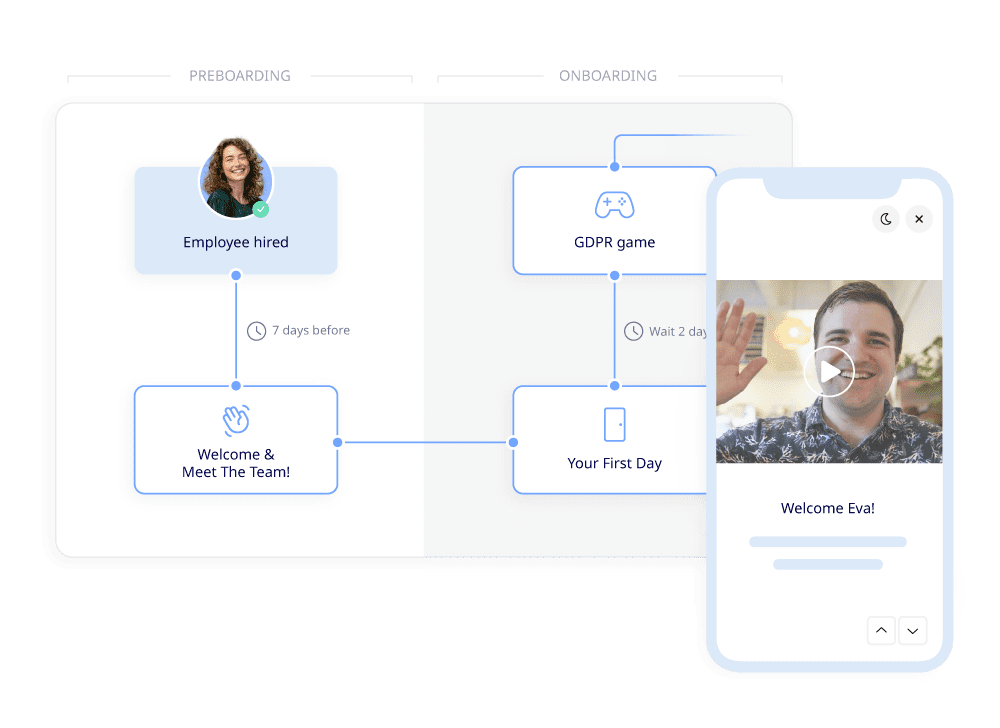
Onboarding: Treat Your Employees Well
A computer, a bouquet of flowers, and a bar of chocolate. The new colleague has been welcomed and is now ready to get to work. Or?
The answer should be an obvious “NO”, but unfortunately, it is a reality in many companies. In fact, 4% of all new employees stop after a disastrous first day, and as we have previously mentioned, 25% of all employees hand in their notice within the first year.
The response to this is a structured, engaging onboarding that helps maintain employees and make them perform more efficiently. And onboarding is, fortunately, something that has already been put into effect at many companies and organizations.
Unfortunately, we often see that the onboarding process becomes just too guided. And in many cases, it consists of a checklist where one can put a checkmark when the email is created and one has remembered to tell the new colleague about the opening hours of the canteen.
Structured onboarding is all about ensuring that the new colleague feels welcome and gets a sense of belonging to the company quickly. And to recognize that being able to perform in a new position requires that you have both the right knowledge and are actually suited to put that knowledge into practice within the context. It requires that one is onboarded properly.
Some of the initial steps will be taken in the preboarding phase, but at this stage of the employee journey it is about getting the new employee into the engine room.
See the video and get inspired by Gudium Catering that support their employees with digital onboarding and continuous learning. 👇 Or read the whole case here.
Take the Employee As a Point of Reference
However, it does not begin in the engine room – or in the company at all – but with the employee. It is about what the employee can contribute to the organization and not vice versa. It begins with the employee’s competencies, which must be put into play in such a way as to contribute to the culture and to achieve the goals of the organization. That talk is essential, and a good way to anchor it in a concrete outcome is to present the new employee to a digital universe to which the employee can go back. Here, you can show the company’s mission and the new employee can get a sense of how they can actually contribute to the mission being pursued.
In order for people to function, some basic things need to be in place. Most people know Maslow’s hierarchy of needs, which describes the needs that people have. The fundamental one that makes up the base of the pyramid are the basic needs such as food, sleep, etc. Once in place, you can start moving up the pyramid.
Remember the Whole Pyramid
The same is true in the context of onboarding. In Learningbank, we have divided the pyramid into three layers, which we (from the bottom up) refer to as Administration, Assimilation, and Acceleration.
The administration step is about all the practicalities – contract, uniform, password to the alarm, and that kind of stuff. The assimilation step is, among other things, about involving the employee in the company’s culture, getting the compliance training on track, and getting clear guidelines in relation to mutual expectations. And at the top of the pyramid is the acceleration step, where the employee has got the base in place and is ready to deliver at the expected level.
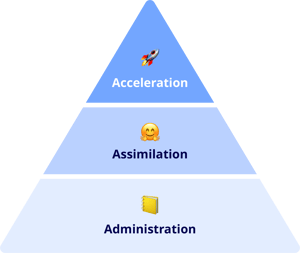
The problem is that many onboarding processes never get past the administrative stage. The intentions may be very good, but the everyday routines take over and no follow-up is made on how the new employee is thriving. The days start to fly by, and suddenly the new employee is either a non-performing employee or a former employee.
Check out how you onboard temporary employees and freelancers in 3 steps.
Digital Aid Ensure the Connecting Thread
A useful tool to ensure that there is a common thread throughout the onboarding process is to make the process digital. Digital learning modules can be “packed” to the individual employee, and you can control when each module is presented to the employee so that it suits their specific situation.
Another and not insignificant advantage of a digital learning platform is that you make the learning accessible to the employee when they – and not you – have time. For example, the use of video in employee onboarding offers a wide range of options for companies hoping to engage and educate employees in a highly effective way.
Make sure that the platform can be accessed across devices so that the training can also be done on the train, on the bus or in the waiting room at the dentist.
In addition, a digital onboarding process allows for the use of gamification. It includes elements from computer games or board games and helps increase motivation and empathy, and it has a noticeable effect on learning outcomes.
Onboarding – important to remember:
- The onboarding process must not be under-prioritized and nor should it be too guided. It is crucial that new employees land in the right way, so set aside time and resources and take the job seriously.
- Take the employee as a point of reference, not the company.
- Remember the whole pyramid – administration, assimilation, and acceleration.

Development & Growth is Crucial
When filmmakers, comedians, and cartoonists have to describe a marriage, they often focus on the difference between the newly in love, beautiful people, who at the beginning of the relationship do everything to be attractive, and the slightly more pudgy, lazy, and resigned state that ensues once the wild flurry of falling in love passes. And at some point, one or both parties begin to look for something better.
In many ways, one can say that many companies face the same challenge. With even the most perfect preboarding and onboarding, it is by no means a guarantee that the relationship between employee and company will last.
The challenge is that everyday life can be a dampener. For many, a lack of development equals termination - at least, the termination of the employment they are in. In a survey conducted by LinkedIn Learning, 94 percent of respondents say they are willing to remain at the job if the company invests in their careers. In the same study, respondents point out that the biggest barrier to developing oneself is the lack of time to learn new things.
This is a huge challenge. Technological development and increasing mobility both increase the need for learning and provide better opportunities for employees to change jobs globally. Or in other words: If what you as a company have to offer is not good enough or does not meet the employee’s expectations, they are, in many cases, just a stable broadband connection away from their prospective workplace.
Maintain a Constant Focus on Development
It is, therefore, essential that you as a company manage to keep the chain tight and have respect for the time that follows the honeymoon phase. It is crucial to put a career plan together with the employee so that they can both see that there is a potential for continued development, as well as letting the employee present their own wishes.
And then, it is essential that a plan is laid out for how ongoing training and development can be squeezed into an otherwise just as busy daily life. Without pushing them to burn out.
The easiest method for creating a focus on training and development is to make it a fixed bullet at the ongoing one-on-one meetings between the employee and their immediate boss. This can ensure that the subject has a place on the agenda at all times.
However, talking about training and development makes no difference if there is no time to do anything about it because of work assignments. So, it is essential that you, as a company, truly facilitate a learning environment and culture that allows the employee to find the time for training.
Time - and, in some ways, the location - is quite crucial for the training to take place on the employee’s terms, which is all the more likely to give the best learning outcome.
According to the survey conducted by LinkedIn Learning, 68 percent of employees prefer to complete their training while they are at work. At the same time, 58 percent prefer to learn at their own pace, while 49 percent prefer to wait to complete learning and training courses until they are in a situation where learning is necessary to complete a task.
All these numbers scream for a tailor-made solution that the employee can access when it fits into their schedule. And that kind of thing can be close to impossible to systematize without a digital learning platform or LMS.
Upskilling & Reskilling
As your company grows, needs can shift. Keeping long-term employees and investing in their development is usually a win for both the company and the employee. You won’t lose their knowledge, and you won’t need to hire and train someone new; plus, your employees, more than often, enjoy and feel appreciated when given the chance to learn something new.
How to tackle employee training In short:
- Look into digital types of learning content as Just-in-time learning and Microlearning, to improve your learning program
- Connect learners to the skills they need to succeed in their role – for the benefit of the learner and the organization
- Create a strong learning culture with knowledge sharing and the use of blended – and social learning – in a digital setting as well
Take Training Seriously
On a busy day, time is often the scarcest resource. And honestly: It is the case with many tasks that if management is not clear about their importance, they will be given a lower priority in favor of tasks that have the focus of the management.
Therefore, consider how much time you are allocating to training as a company. And by allocation, we mean real allocation. Should employees spend 15, 10 or 1 percent of their time developing and training themselves? And where and when should that time be scheduled?
Have respect for the training, take it seriously, and systematize it. If it does not suit your everyday life to devote a quarter, half, or whole days, microlearning can be a good idea - provided, of course, that it is implemented properly.
Development & Growth – important to remember:
- Remember to maintain the relationship when the initial exercises are over. A good onboarding is important, but so is everyday life, so keep the steam up.
- 94% of respondents in a large LinkedIn survey point out that they are willing to remain at the job if the company invests in their careers.
- Make sure the ongoing training and learning process takes place on the employee’s terms.

Reboarding: New Situations Require New Insights and Efforts
The fourth stage of the employee journey is reboarding - in some contexts also referred to as cross boarding. At this stage, the employees for one reason or another must join either a new job function, department, or team, or come back to a position after some time away. On the surface, they might be expected to fit in without any further ado, but where there in fact is a real need to organize a process reminiscent of onboarding.
Let’s imagine a scenario where an employee at a marketing department returns to work after ten months of parental leave. The employee returns to the same position, but the department has been merged with another department, and new ways of working have been implemented, and a new manager is in charge.
In many companies, the employee will be welcomed back with a meeting with the new manager, where the most important changes are reviewed, and then it's just a matter of getting up to speed. In reality, the employee is in a whole new world where the changes have not come gradually but must be digested all in one go.
It may seem like a minor challenge, but what if it was you who were faced by a whole new reality with new workflows, and everyone else went about their business without making sure that you could keep up?
Or a scenario where a skilled IT employee exhibits exceptionally good business sense and is therefore placed in a new team to act as a technical expert at customer meetings. The address is the same, the office is a little further down the hallway, and they can sit with their former colleagues for lunch. In other words: The difference is not that huge.
But yet again, In reality, the IT employee has changed jobs and a lot is new. The IT employee has ended up in a new team that speaks a different language and has other KPIs, and it is not entirely clear what the manager’s and coworkers’ expectations are
Changes Place a Great Demand on People
The example of the employee at the marketing department is about reboarding, while the IT employee is being crossboarded. Common to both is their need for the process to be taken seriously and for the organisation to recognize that change places great demands on people.
And this is where a comparison can be made to onboarding. Prior to the change, the employee must have a whole lot of information, and in the start-up to what is in fact a new start, they must be guided, trained, and helped in order to deliver what is expected.
For example, an employee who has either been away from the company or has to occupy a new position will typically need a course or go through a training process that ensures that they are GDPR compliant in relation to the function they now have. In addition, there will often be some cultural and quite low-level practical things like handling IT and alarm systems, just as there may be a need to make them both feel and be perceived as part of the group.
In the vast majority of cases, it would be a good idea to approach the reboarding and crossboarding processes in a rather structured way, minimising the risk that the employee either has an unnecessarily long start-up period or simply loses the motivation to work in company.
Therefore, think of having a close dialogue in good time before the employee returns to the company or changes to another department, and if possible give them a support person in the form of a colleague who can answer the “dumb” questions and make the employee feel safe.
Remember to prepare the team for a new (or old) co-worker, and make it clear to all parties what their roles and functions are, and what expectations there are for both the employee and the team in relation to getting things to form a synthesis.
Digital Solutions Provide Many Advantages
In theory, all this can be done with a checklist, but in reality, most people know how this turns out with such things: It doesn’t work. Instead, think about digital solutions where the reboarding and cross boarding processes are systematized, and where, for example, the GDPR training is a learning module that the employee can access when it fits their calendar.
Also, keep in mind that by having training digitally available, you are eliminating the risk that old versions of different types of knowledge flourish. Digital learning systems ensure that you can update the material centrally and thus maintain control. They also ensure that you can easily and conveniently create a personalized learning process tailored to the specific needs of each employee.
Read more on how to make your learning more personalized.
An important note: Look for signs of disease. The reboarding and cross-boarding process involves an increased risk of things going wrong. If a seasoned and valued employee returns from maternity leave and feels that the workplace she has ended up in is significantly different from the one she left, her incentive to apply for a job elsewhere is great.
Likewise, the super-skilled IT specialist can feel left behind in a no-man’s land where the professional network is gone and where the new colleagues neither fully understand nor appreciate who he is and what he is able to do. That employee won’t hang around for long.
In order to remain in the hospital ward, a structured reboarding and cross boarding initiative is generally important in terms of countering cultural and stress challenges at the workplace. The whole mental aspect is extremely important; we spend such a great part of our waking hours at work that it simply needs to be exciting, developing, and socially enjoyable to meet up every day.
Functioning well at work is far from just a matter of being professionally skilled – if the other parameters are imbalanced, the risk of toppling is great. And a toppled employee becomes a problem first for HR and then for the bottom line.
Reboarding – important to remember:
- Have respect for employees who return from maternity leave or sick leave or have a new function in the company. They may require a “restart”.
- Respect that the employee may need both practical and cultural acclimatization – remember both the new codes for the door and the codes for the culture.
- Prepare the team for a new player to join the team and ensure that expectations are aligned.
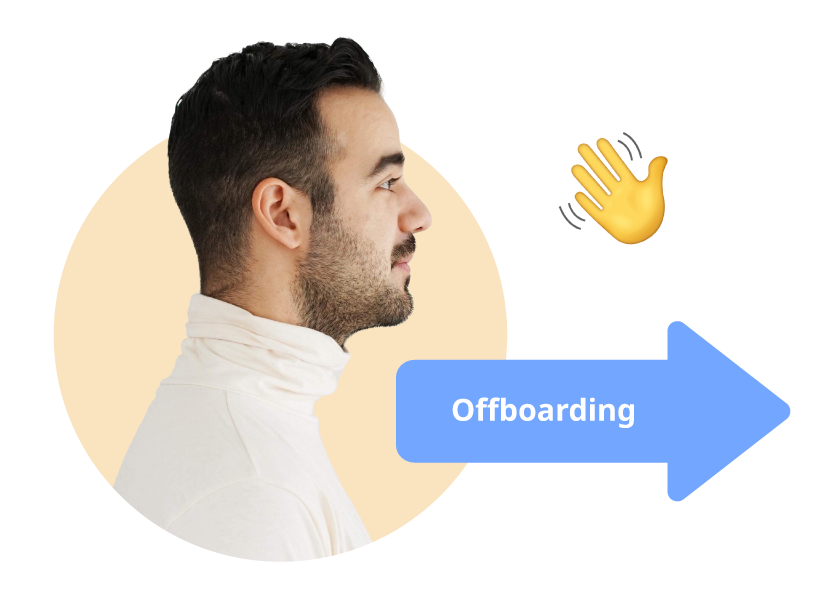
Offboarding: For a Bad Resignation and A Good Farewell
No one remains at their job forever. Either there will be a day when retirement can no longer be postponed or there will be a day when either the employee or the company says stop. Perhaps the employee requires new stimuli, and perhaps the employer reckons that there is a need for new labor.
Whether the divorce occurs on happy terms or not, it is crucial that you, as a company, have a plan for how to say goodbye to an employee.
Be Proper When Firing
Let's look at terminations. There may be many legitimate reasons why you will have to say goodbye to an employee, but few people think it is a fun situation to be in. It places a number of demands on the employer – both for ethical and strategic reasons.
First and foremost, people should be treated with respect. Whether you are terminated as a result of poor economics, a horrible climate of cooperation, bad performance, or something else, you as an employer are “the strong” party, and that responsibility should be taken seriously.
In the case of sudden or acute dismissal, it is essential that a contingency plan is ready. There must be a plan for who is to present the termination, as well as where and when it should be done, as well as a procedure for how equipment is returned – for example, IT or special equipment.
Keep in mind that the employee is vulnerable no matter what, so make sure, among other things, that they do not walk away agitated from the termination and through an office landscape in order to get away from the company. It’s trivial, but it’s important.
And make sure that there is a clear roadmap for how access to different IT systems, email accounts, and so on can be cut immediately.
If the employee has not been terminated due to, for example, criminal circumstances, but “simply” has not really picked up the pace or is a victim of too few orders, you should allow them to say goodbye to their soon-to-be former coworkers. Maybe not on the day of the termination, but during a visit to the company after some time. Maybe you’re wondering what value it might have for your business, but we’ll get back to this.
Make a Former Employee Into a New Ambassador
To a large extent, most workplaces resemble a football club. Everyone has an interest in the players performing at the highest level, but if it goes too well, they become attractive to the market.
However, one rarely gets a gigantic transfer fee when the key employee changes jobs, but in return, you can get something else – a potential customer, an ambassador, or some insight.
If you are able to depart in a good way, you will have someone who knows you and your business, and it is likely that they will be interested in building a business relationship if it is relevant in the new job.
With regard to employer branding, it is imperative that you have as many ambassadors out there as possible. In the fight for talent, many companies are selected or rejected based on soft parameters such as the working environment and culture, and in that game, it can be expensive to end up with a reputation as a place where it is not nice to be. It is also in relation to this that it may be a good idea to keep the door open for employees that you have actually fired. By being accommodating, you increase the likelihood that they will actually act as your ambassadors, rather than becoming bards of tales of how bad a place your business is.
What to Keep in Mind When an Employee Has to Leave::
- Communicate that the employee is stopping. Make sure that the closest employees, as well as customers, are informed that the employee is stopping. It minimizes the risk of rumors, and it allows you to signal to the customers that you have a grip on the situation.
- Systematise the knowledge transfer. Make sure that as much know-how as possible remains in the company, even if the employee disappears. Document as much as possible.
- Manage the technical systems. As we have previously mentioned, access to the IT systems must be blocked, and the office must be cleared. Take IT security people on board, but beware of being too “hysterical” – allow the employee to get their own personal stuff from the workstation, but of course, have respect for the company’s data.
- Thank the employee. Be sure to thank employees who have been good to have in the company. And also make it public. It promotes a good culture if one can leave the place and still get a bouquet of roses, and it signals to the rest of the staff that good employees are appreciated.
- Conduct exit-interviews. Ask your employees why they are leaving. Ask them what would have made them stay. And ask them what they’ve received at their new workplace that they could have used when they were with you. Exit interviews provide a lot of insight into your business that can be used for both recruiting and retaining employees. If necessary, wait until your former employee has been at their new job for a few months, but make the appointment when they stop with you.
Offboarding – important to remember:
- Whatever the reason is why an employee stops, keep in mind that they are an ambassador once they leave. Everyone wins by a respectful and proper break
- Be prepared. Ensure that access to IT is shut down so that data security is under control
- Look the former employee in the eyes and delve into why they left the company. Exit interviews can give you invaluable knowledge and insight into your own business

Good Preparation Provides a Better Employee Journey & Experience
Recruiting and managing employees is not a simple task. People are different, and different situations require different initiatives. But no matter what, as an employer, you have both a responsibility and a clear interest in the right people getting the right treatment in the right situation.
Since 'employee journey' has become a term that needs to be addressed, it is because competent and talented employees are perhaps the most scarce resource for many companies.
Real brains and soft skills are the catalysts that make the wheels spin, and a structured employee journey strategy is the tool companies can use in ensuring that the right people get the best conditions for delivering the product from day one. And that they are given the biggest incentives to remain at their job – people are staying at their job for an even shorter period, and 43% of the millennial generation are expected to change jobs every two years. In other words, there is good reason to optimize the employee journey and thus increase the likelihood that passengers feel like remaining a little longer on the train.
The greatest risk of failure is to allow everyday life and the focus on operations, which constantly have a habit of getting precedence, divert focus from the task of preboarding and onboarding new employees, to ensure the individual’s personal and professional development, to reboard or crossboard people to new functions and invite them back after maternity leave, leave of absence and the like, and finally to make sure to properly say goodbye to those who leave the company.
Therefore, you should take the employee journey seriously and consider whether you should invest in software that can help you streamline and enhance the efficiency of the process.
Either way, we hope that you and your employees – both the current as well as future ones – have the best opportunities to make each other better. For the benefit of the corporate culture and the bottom line.
We wish you a safe journey!
Download the full
e-book
